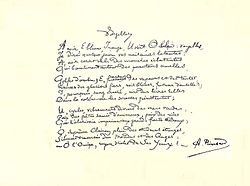A noir, E blanc, I rouge, U vert, O bleu, voyelles,
Je dirai quelque jour vos naissances latentes.
A, noir corset velu des mouches éclatantes
Qui bombillent autour des puanteurs cruelles,
Golfes d’ombre : E, candeur des vapeurs et des tentes,
Lance des glaciers fiers, rois blancs, frissons d’ombelles ;
I, pourpres, sang craché, rire des lèvres belles
Dans la colère ou les ivresses pénitentes ;
U, cycles, vibrements divins des mers virides,
Paix des pâtis semés d’animaux, paix des rides
Que l’alchimie imprime aux grands fronts studieux
O, suprême Clairon plein de strideurs étranges,
Silences traversés des Mondes et des Anges :
— O l’Oméga, rayon violet de Ses yeux ! | | Black A, white E, red I, green U, blue O: you vowels,
Some day I'll tell the tale of where your mystery lies:
Black A, a jacket formed of hairy, shiny flies
That buzz among harsh stinks in the abyss's bowels;
White E, the white of kings, of moon-washed fogs and tents,
Of fields of shivering chervil, glaciers' gleaming tips;
Red I, magenta, spat-up blood, the curl of lips
In laughter, hatred, or besotted penitence;
Green U, vibrating waves in viridescent seas,
Or peaceful pastures flecked with beasts – furrows of peace
Imprinted on our brows as if by alchemies;
Blue O, great Trumpet blaring strange and piercing cries
Through Silences where Worlds and Angels pass crosswise;
Omega, O, the violet brilliance of Those Eyes! |

![Rimbaud caricatured by Luque in the review Les Hommes d'aujourd'hui [fr] in January 1888. Rimbaud Voyelles caricature.jpg](http://upload.wikimedia.org/wikipedia/commons/thumb/c/c5/Rimbaud_Voyelles_caricature.jpg/250px-Rimbaud_Voyelles_caricature.jpg)